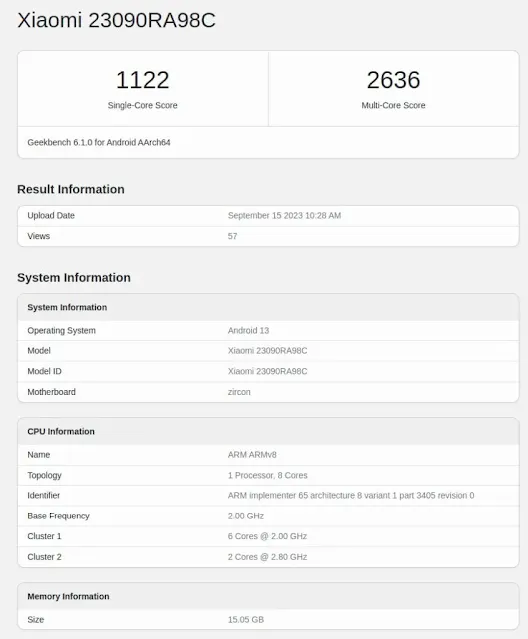Redmi Note 13 Pro Confirmed to Get Snapdragon 7s Gen 2 SoC, 16GB RAM & More
Xiaomi is once again making headlines with its upcoming release, the Redmi Note 13 Pro. This eagerly anticipated phone is set to be the first device to feature the Snapdragon 7s Gen 2 4nm SoC, promising a powerful performance boost. Benchmarks for the Redmi Note 13 Pro, identified by its model number 2312CRAD3C, have recently surfaced on Geekbench, shedding light on its performance capabilities.
Additionally, the listing reveals an impressive 16GB of RAM, hinting at a device that's set to impress. In this article, we'll delve deeper into the specifications and implications of the Redmi Note 13 Pro, comparing it to its competitors and exploring what this means for the budget-conscious consumer.
Snapdragon 7s Gen 2 4nm SoC:
The heart of the Redmi Note 13 Pro is the highly anticipated Snapdragon 7s Gen 2 4nm SoC. This system-on-a-chip is engineered to deliver an exceptional performance, and its benchmarks do not disappoint. The SoC comprises four Cortex A78 cores clocked at 2.4GHz, coupled with four Cortex A55 cores ticking away at 1.96GHz.Qualcomm has also confirmed support for UFS 4.0 and LPDDR5 RAM, ensuring lightning-fast data transfer and multitasking capabilities. To handle graphics, the Snapdragon 7s Gen 2 boasts the Adreno 710 GPU, which has previously been utilized in the Snapdragon 6 Gen 1 SoC.
Geekbench Scores:
The Geekbench listing for the Redmi Note 13 Pro has given us an intriguing peek into its performance potential. The single-core score of 1012 and multi-core score of 2943 align closely with previous rumors that suggested performance in the range of the Snapdragon 778G/778G+/782G. These processors share similar architecture, differing mainly in clock speeds.The implication here is that the Redmi Note 13 Pro could deliver a comparable level of performance to its pricier counterparts powered by the Snapdragon 7+ Gen 2 SoC, such as the Redmi Note 12 Turbo or POCO F5.
One of the most significant takeaways from these benchmark results is the potential affordability of the Redmi Note 13 Pro. By opting for the Snapdragon 7s Gen 2 4nm SoC, Xiaomi may be able to offer a high-performance device at a more budget-friendly price point.
This could make it an attractive choice for consumers who seek top-tier performance without breaking the bank. It's worth noting that Xiaomi has a track record of providing excellent value for money in their smartphones, and the Redmi Note 13 Pro appears to be no exception.
Redmi Note 13 Pro+:
In addition to the Redmi Note 13 Pro, Xiaomi has also teased the Redmi Note 13 Pro+ with the model number Xiaomi 23090RA98C. This variant is powered by the MediaTek Dimensity 7200-ultra chipset. Interestingly, it shares similarities with the Dimensity 7200, featuring 2 Cortex-A715 cores clocked at 2.8GHz and 6 Cortex-A510 cores operating at 2.0GHz. The Geekbench listing for the Redmi Note 13 Pro+ also reveals an impressive 16GB of RAM, which indicates that Xiaomi is aiming for a seamless multitasking experience.Benchmark Performance:
The benchmark scores for the Redmi Note 13 Pro+ with the MediaTek Dimensity 7200-ultra are in line with expectations for this chipset. It demonstrates that Xiaomi is positioning this device to compete effectively in its segment. MediaTek has been gaining ground in the smartphone market with its robust and efficient chipsets, and the Dimensity 7200-ultra is no exception. It promises a smooth user experience, excellent gaming performance, and support for advanced features.Xiaomi's strategy of offering both Snapdragon and MediaTek-powered variants of their smartphones is a shrewd move. It allows them to cater to a broader range of consumers with varying preferences and requirements. Both the Snapdragon 7s Gen 2 and MediaTek Dimensity 7200-ultra offer impressive performance in their respective categories. This competitive landscape benefits consumers who can choose a device that suits their needs and budget.
Importance of Benchmarks:
Benchmarks like those found on Geekbench are valuable tools for consumers and tech enthusiasts. They provide a glimpse into a device's real-world performance, helping potential buyers make informed decisions. It's important to note that benchmarks are just one aspect of a smartphone's overall performance. Real-world usage, software optimization, and user experience also play crucial roles in determining the quality of a device.Verdict:
The Redmi Note 13 Pro is generating excitement in the smartphone world for good reason. With the Snapdragon 7s Gen 2 4nm SoC and 16GB of RAM, it promises to offer high-end performance at a competitive price point. Xiaomi's decision to provide MediaTek-powered variants, like the Redmi Note 13 Pro+ with the Dimensity 7200-ultra, demonstrates their commitment to giving consumers a wide range of options.As the smartphone market continues to evolve, Xiaomi's approach of delivering value-driven devices with impressive specifications ensures that they remain a top contender in the industry. The benchmarks are just the beginning of the story, and we eagerly await the official launch to see how these devices perform in the real world.


